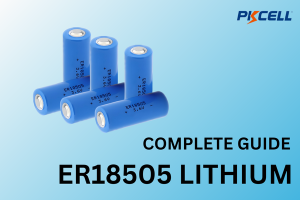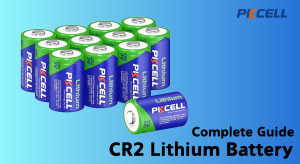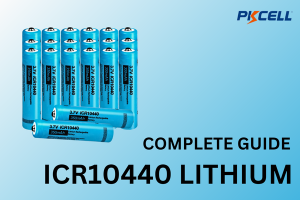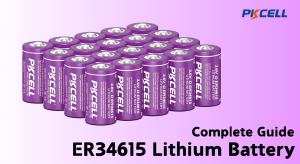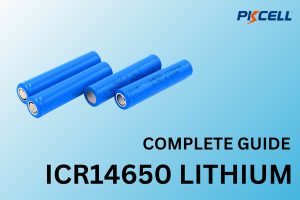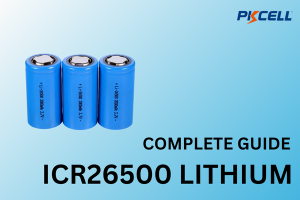Aspectos más destacados
- Voltage Basics: 3.6V–3.7V is the average discharge voltage; 0.1V difference is just labeling.
- Powerful & Versatile: High energy density and stability for phones, EVs, and drones.
- There are seven types: ICR, INR, IFR, etc., each with unique strengths (e.g., ICR18650, IFR26650).
- Easy Selection: Pick NCA for energy, LIP for shape, ER for longevity—match your needs.
- 3.6V vs. 3.7V: Nearly identical; devices don’t mind the 0.1V gap.
- Broad Uses: From wearables to solar, they power modern life.
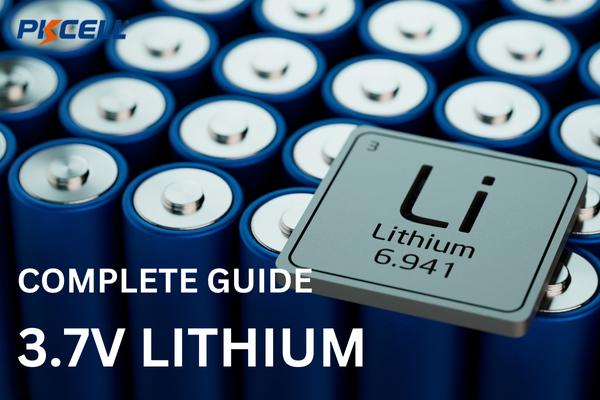
Introducción
In today’s world, we use many portable electronics. Lithium batteries are very important for them. The 3.6V lithium-ion battery is one of the best. In this article, we will explore the type of 3.6v lithium battery, their benefits, applications and how to choose the right lithium battery for your project.
Why is the voltage of lithium-ion batteries around 3.6 to 3.7v?
- Electrode Materials and Potential Difference
Lithium batteries have a positive (cathode) and negative (anode) part. The voltage comes from the difference between them. Materials like lithium cobalt oxide (positive part) create around 3.9–4.0 volts, while graphite (negative part) makes about 0.1–0.2 volts in lithium batteries. This voltage difference determines the cell’s total voltage, usually around 3.6–3.7 volts when discharged fully.
- Practical and Safe Design
Lithium-ion batteries shuttle lithium ions between the cathode and anode through an electrolyte.
The 3.7-volt range is a sweet spot for graphite-based anodes and transition-metal-oxide cathodes, balancing energy density, stability, and safety. Higher voltages can provide more power but may compromise safety, while lower voltages might not meet the power requirements of modern electronics. The 3.6V to 3.7V range strikes a balance that makes lithium-ion batteries versatile and efficient for various applications.
In short, the 3.6–3.7 volts come from the inherent properties of the materials used and the physics of how lithium ions move in the battery, optimized for performance, safety, and longevity. Different chemistries (like lithium iron phosphate, LiFePO₄, at ~3.2 volts) can shift this voltage, but 3.7 volts is the norm for many common lithium-ion cells.
Key Characteristics and Benefits of 3.6V Lithium Battery
3.6V lithium batteries have several important features. They have high energy density, long life, and strong voltage stability. These batteries are easy to maintain and work well for a long time, making them perfect for many industrial applications. Their small and light design fits the needs of modern devices. They provide steady energy for laptops, flashlights, and other electronics with a nominal voltage of 3.6V.
- Tensión nominal:
- Typically 3.6–3.7 volts, are determined by the electrochemical potential difference between the cathode (e.g., lithium cobalt oxide) and anode (e.g., graphite).
- Alta densidad energética:
- Stores a significant amount of energy per unit of weight or volume (typically 150–250 Wh/kg), far exceeding older technologies like NiMH or lead-acid batteries.
- Recargable:
- Based on lithium-ion intercalation chemistry, allowing hundreds to thousands of charge-discharge cycles (often 500–2000 cycles depending on usage and quality).
- Baja tasa de autodescarga:
- Loses only about 1.5–2% of its monthly charge when idle, compared to 20–30% for NiMH batteries.
- Lightweight:
- Lithium’s low atomic weight and the battery’s efficient design make it much lighter than alternatives with similar capacity.
- Amplia gama de temperaturas de funcionamiento:
- It effectively functions between -20°C and 60°C, though optimal performance is typically at room temperature (20–25°C).
- Sin efecto memoria:
- Unlike older nickel-based batteries, lithium-ion cells don’t lose capacity if partially discharged before recharging.
- Variable Capacity:
- Available in various capacities (e.g., 1000 mAh to 5000 mAh or more), depending on size and design (e.g., 18650 cells, pouch cells).
Overview of Common Applications.
3.6V lithium batteries are found in many devices. You can see them in consumer electronics, medical devices, and power tools. People often use these rechargeable batteries in laptops, flashlights, and digital cameras. They are popular because they have high energy density and last a long time. These batteries also work well for wireless devices, remote controls, and electric toys. In the industry, they support essential tasks such as automation systems and backup power. This shows they are both valuable and dependable.

Why 3.6V Lithium Batteries Excel in These Applications
- High Voltage: A single 3.6V cell provides more power than lower-voltage alternatives (e.g., 1.2V NiMH), reducing the need for multiple cells.
- Densidad energética: Enables compact designs without sacrificing runtime.
- Recargabilidad: Supports repeated use and is critical for portable and cost-sensitive applications.
- Versatilidad: It is available in various sizes (e.g., cylindrical 18650, 18500, 21700, 26650, etc.) to fit diverse needs.
From tiny wearables to massive EV packs, the 3.6V lithium-ion battery’s balance of power, efficiency, and adaptability makes it a cornerstone of modern technology.
Types of 3.6V Lithium Batteries
The 3.6V lithium battery category encompasses seven types, distinguished by their specific chemistries, form factors, and performance characteristics. Each type of lithium battery has its pros and cons and is best for different purposes. Knowing these differences can help you choose the right battery for your device.
Below is an overview of the seven types of 3.6V lithium batteries:

1. LiCoO₂ or LCO Battery – Abbreviation: ICR
- Tensión nominal: 3.6–3.7V
- Hot Sell Models: ICR18650
- Características:
- High energy density (~150–200 Wh/kg).
- Compact and lightweight.
- Moderate cycle life (500–1000 cycles).
- Usos comunes:
- Smartphones, laptops, and other consumer electronics
- Pros:
- Excellent energy storage for small devices.
- Contras:
- Limited thermal stability; prone to overheating if overcharged.
- Cobalt is expensive and ethically controversial.
2. LiMn₂O₄ or LMO Battery – Abbreviation: IMR
- Tensión nominal: 3.6–3.7V
- Hot Sell Models: IMR18650, IMR26650
- Características:
- Good power output and thermal stability.
- Energy density (~100–150 Wh/kg) is lower than LCO.
- Decent cycle life (300–700 cycles).
- Usos comunes:
- Power tools, medical devices, and some electric vehicles.
- Pros
- Lower cost than cobalt-based batteries.
- Safer than ICR due to better thermal stability.
- Cons
- Reduced capacity and shorter lifespan compared to other chemistries.
3. LiNiMnCoO₂ or NMC Battery – Abbreviation: INR
- Tensión nominal: 3.6–3.7V
- Hot Sell Models: INR18650, INR21700
- Características:
- Balanced energy density (~150–220 Wh/kg).
- High power capability and long cycle life (1000–2000 cycles).
- Usos comunes:
- Electric vehicles, e-bikes, laptops, and energy storage systems.
- Pros
- Versatile performance with good safety and longevity.
- Cons
- More complex and costly to manufacture than single-metal chemistries.
4. LiNiCoAlO₂ or NCA Battery – Abbreviation: INR (shared with NMC in some cases)
- Tensión nominal: 3.6–3.7V
- Hot Sell Models: INR18650, INR21700 (often branded specifically by manufacturers like Tesla)
- Características
- Very high energy density (~200–260 Wh/kg).
- Excellent specific power for demanding applications.
- Cycle life (~1000–1500 cycles).
- Usos comunes
- Electric vehicles (e.g., Tesla models), high-performance drones, and power tools.
- Pros
- Maximizes energy storage and power output.
- Cons
- Less thermally stable than INR (NMC) or IMR; requires careful management.
- Higher cost due to nickel and cobalt content.
5. Lithium Iron Phosphate (LiFePO₄ or LFP) Battery – Abbreviation: IFR
- Tensión nominal: ~3.2V (slightly below 3.6V, but often grouped with 3.6V batteries)
- Hot Sell Models: IFR18650, IFR26650
- Características
- Lower energy density (~90–160 Wh/kg).
- Exceptional cycle life (2000–5000 cycles).
- Superior thermal and chemical stability.
- Solar storage, e-bikes, backup power, and some EVs.
- Pros
- Extremely safe and long-lasting.
- Cost-effective over time due to durability.
- Lower voltage (3.2V) and energy density limit its use in compact, high-energy devices.
6. Lithium Polymer (LiPo) Battery – Abbreviation: LIP
- Tensión nominal: 3.6–3.7V
- Hot Sell Models: LIP503759 (5mm x 37mm x 59mm, pouch format; sizes vary widely)
- Features:
- High energy density (~150–250 Wh/kg, similar to ICR).
- Flexible, lightweight pouch design with a solid or gel polymer electrolyte instead of liquid.
- Good cycle life (300–1000 cycles, depending on usage).
- Usos comunes
- Drones, RC vehicles, smartphones, wearables, and thin laptops.
- Pros:
- Customizable shapes and sizes for compact or irregular devices.
- Lightweight with no rigid casing, maximizing energy-to-weight ratio.
- Cons:
- Less durable than cylindrical cells; prone to swelling or damage if mishandled.
- Requires careful charging to avoid overvoltage or puncture risks.
7. Lithium Thionyl Chloride (LiSOCl₂) Battery – Abbreviation: ER
- Tensión nominal: 3.6V
- Hot Sell Models: ER14505 (AA size), ER34615 (D size)
- Características
- Very high energy density (~500–700 Wh/kg).
- Non-rechargeable (primary battery) with an extremely low self-discharge rate (<1% per year).
- Long shelf life (10–20 years) and wide temperature range (-55°C to 85°C).
- Common Uses:
- Utility meters, remote sensors, military equipment, and medical implants (e.g., pacemakers).
- Pros
- Exceptional longevity and reliability for low-power, long-term applications.
- Performs well in extreme environments.
- Cons:
- Non-rechargeable, limiting it to single-use scenarios.
- High initial cost and not suited for high-drain devices.
Choose the Right Type of Lithium Battery

Selecting the perfect 3.6V–3.7V lithium battery from the seven options—ICR, IMR, INR, NCA, IFR, LIP, and ER—can feel a bit overwhelming, but don’t worry! I’m here to break it down for you.
By considering your specific application, performance requirements, safety, cost, and longevity, I’ll provide tailored suggestions to help you confidently choose the best battery for your needs.
Step 1: Define Your Application and Requirements
Consider the following questions:
- Is it rechargeable or single-use? Most are rechargeable (ICR, IMR, INR, NCA, IFR, LIP), but ER is non-rechargeable.
- What’s the power demand? High-drain (e.g., power tools) vs. low-drain (e.g., sensors).
- How much space do you have? Compact devices need a pouch (LIP) or small cylindrical cells (e.g., 18650).
- What’s the environment? Extreme temperatures or safety-critical uses narrow your options.
- How long should it last? Cycle life (rechargeable) or shelf life (non-rechargeable) matters.
Step 2: Evaluate Key Factors
Here’s how each battery type aligns with specific needs:
1. Energy Density (Capacity per Size/Weight)
- Best Choices
- NCA (INR): ~200–260 Wh/kg – Ideal for EVs and drones needing maximum energy in minimal space.
- LIP: ~150–250 Wh/kg – Great for slim, lightweight devices like phones or wearables.
- ICR: ~150–200 Wh/kg – Good for compact electronics like laptops.
- Lower Energy Density
- IFR: ~90–160 Wh/kg – Less energy but safer and longer-lasting.
- IMR: ~100–150 Wh/kg – Prioritizes power over capacity.
2. Power Output (High Drain vs. Low Drain)
High-Drain Needs (e.g., power tools, vaping, drones):
- IMR: Excellent power delivery and thermal stability.
- INR (NMC or NCA): High power with decent energy density.
- LIP: High discharge rates for RC vehicles or drones.
Low-Drain Needs (e.g., sensors, meters):
- ER: Perfect for ultra-low power over decades.
- IFR: Stable for steady, moderate loads.
3. Cycle Life (Rechargeable Durability)
Longest Life:
- IFR: 2000–5000 cycles – Best for solar storage or e-bikes.
- INR (NMC): 1000–2000 cycles – Reliable for EVs and laptops.
- NCA: 1000–1500 cycles – Good for high-energy applications.
Moderate Life:
- ICR: 500–1000 cycles – Sufficient for consumer electronics.
- LIP: 300–1000 cycles – Varies with care and use.
- IMR: 300–700 cycles – Shorter due to power focus.
Non-Rechargeable:
- ER: Single-use, but lasts 10–20 years on shelf.
4. Safety and Thermal Stability
- Safest Options:
- IFR: Exceptional stability, low risk of fire – Ideal for safety-critical uses (e.g., EVs, backups).
- IMR: Good thermal stability for high-drain tasks.
- INR (NMC): Balanced safety for versatile use.
- Less Safe (Need Management)
- ICR: Prone to overheating if mishandled.
- NCA: High energy but less stable than NMC or IFR.
- LIP: Risk of swelling or fire if punctured or overcharged.
- Stable for Lower Power:
- ER: Very safe for long-term, low-drain use.
5. Form Factor and Size
-
Compact/Flexible
- LIP: Pouch format fits irregular shapes (e.g., wearables, drones).
- Standardized CYlindrical
- ICR, IMR, INR, NCA, IFR: 18650, 21700, 26650 for easy assembly in packs (e.g., EVs, flashlights).
- Small or Specific
- ER: AA (ER14505) or D (ER34615) sizes for meters or sensors.
6. Temperature Range
- Extreme Conditions
- ER: -55°C to 85°C – Best for harsh environments (e.g., military, remote sensors).
- IFR: -20°C to 60°C – Reliable in cold or hot climates.
- Standard Range
- ICR, IMR, INR, NCA, LIP: -20°C to 60°C, but optimal at 20–25°C; performance drops at extremes.
Here is a summary table you can check quickly:
|
Tipo |
Abbreviation |
Tensión |
Best For |
Key Strength |
Weakness |
|---|---|---|---|---|---|
|
ICR |
ICR18650 |
3.6–3.7V |
Electronics |
Alta densidad energética |
Thermal instability |
|
IMR |
IMR18650 |
3.6–3.7V |
Herramientas eléctricas |
High power, safety |
Lower capacity |
|
INR |
INR21700 |
3.6–3.7V |
EVs, laptops |
Balance of power/energy |
Costly |
|
NCA |
INR18650 |
3.6–3.7V |
EVs, drones |
Max energy density |
Less stable |
|
IFR |
IFR26650 |
3.2V |
Solar, e-bikes |
Safety, long life |
Lower energy |
|
LIP |
LIP503759 |
3.6–3.7V |
Drones, wearables |
Flexible, lightweight |
Fragile |
|
ER |
ER14505 |
3.6V |
Sensors, meters |
Long shelf life |
No recargable |
What is the Difference Between 3.6V and 3.7V Lithium Batteries?
When browsing lithium batteries, you might notice some are labeled as 3.6V while others are marked as 3.7V. This small 0.1V difference often sparks curiosity, but in reality, it’s not a significant distinction.
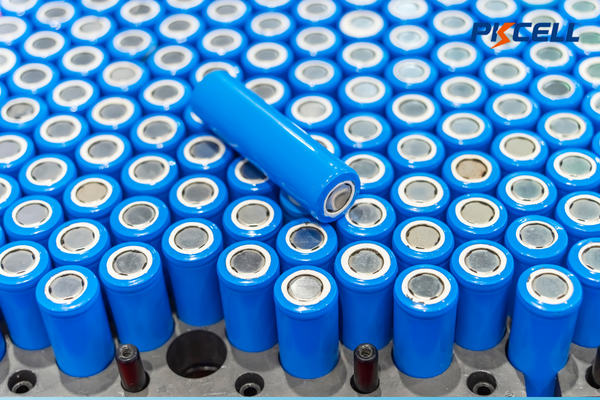
It’s Mostly a Labeling Preference
The difference between 3.6V and 3.7V lithium batteries is primarily a matter of manufacturer convention rather than a major variation in performance or chemistry. Both refer to the nominal voltage—the average voltage a battery delivers during its discharge cycle. A lithium-ion battery starts at around 4.2V when fully charged and drops to 2.5–3.0V when nearly depleted. The 3.6V or 3.7V figure is simply the midpoint of this range, and manufacturers choose one or the other based on their testing standards or marketing habits. For example:
- 3.6V: Often used in older standards or by some brands for consistency.
- 3.7V: More common in modern consumer batteries, like ICR18650 cells, as it slightly better reflects the average discharge voltage.
No Real Impact on Performance
This 0.1V gap—about 2.7% of the nominal voltage—is negligible in practice. Whether a battery is labeled 3.6V or 3.7V, its key traits like capacity (mAh), power output, and lifespan depend far more on its chemistry (e.g., ICR, INR, LIP) and construction than this tiny voltage difference. For instance, a 3.7V ICR battery and a 3.6V ICR battery of the same size and quality will perform virtually identically.
Will Your Device Notice?
Most devices won’t care about the 0.1V difference. Electronics are designed to handle a range of voltages (typically 3.0V to 4.2V) thanks to built-in regulators or battery management systems (BMS). The device will adjust seamlessly whether you use a 3.6V or 3.7V lithium battery. This small variance might matter only in rare cases—like precision equipment without voltage regulation—but such scenarios are uncommon.
Conclusión
In conclusion, understanding 3.6V lithium batteries is crucial. This knowledge aids in selecting the best power source. You may like lithium-ion’s efficiency, lithium polymer’s flexibility, or lithium iron phosphate’s safety, so selecting the right battery type and model is vital. Compare their performance with other batteries for a wise decision. Also, consider common queries such as disposal and lifespan for responsible usage. If you require assistance with lithium batteries, consult Pkcell for pricing and samples that suit your business needs.
Why Choose Pkcell Lithium Battery
With over 20 years of experience powering industries worldwide, PKCELL’s commitment to quality, innovation, and customer satisfaction is built into every lithium battery we produce.
Backed by certifications like IEC, CE, and RoHS and trusted by major brands like Walmart, our lithium battery offers a reliable, long-lasting power solution you can depend on. Ready to experience the PKCELL difference? Póngase en contacto con nosotros to discuss your lithium battery needs and explore how we can create a customized power solution for you!

Preguntas frecuentes
How do I properly dispose of 3.6V lithium batteries?
Lithium batteries, such as the 3.6V type, must not be thrown in regular trash. You should reach out to your local recycling center or find battery recycling programs to get rid of them correctly. This practice is good for sustainability and helps protect the environment.
What’s the average lifespan of a 3.6V lithium battery?
En lifespan of pilas recargables, like 3.6V lithium batteries, is mainly measured in charge cycles. It usually falls between 300 and 1000 cycles, but this can vary depending on how they are used and charged. The densidad energética also matters. A higher mAh rating usually means the battery lasts longer.
Are there rechargeable options for 3.6V lithium batteries?
Yes, many 3.6V lithium batteries, especially lithium-ion ones, can be recharged. Brands like Tenergy make good rechargeable 3.6V batteries. This matters for sustainability and helps reduce waste.
Can I replace 3.6v Li-Ion batteries with 3.7v ones?
In most situations, yes. A small voltage difference is generally okay for devices that use 3.6V lithium-ion batteries. However, it’s a good idea to check if your device is compatible first. This can help you avoid issues later.
Best place to source new 3.6v half AA batteries?
Amazon is a good place to buy 3.6-volt half-AA batteries. They have a wide selection and good prices. You can also enjoy free shipping on many items. In addition to Amazon, you can find these batteries at electronics stores or special battery shops for your accessories.
How to Measure the State of Charge on a 3.6 V Lithium Battery?
The simplest way to know the State of Charge of a 3.6 V lithium battery from Xeno is to use a multimeter to check its voltage. You should look at the battery’s datasheet to find the voltage levels for various charge amounts.

